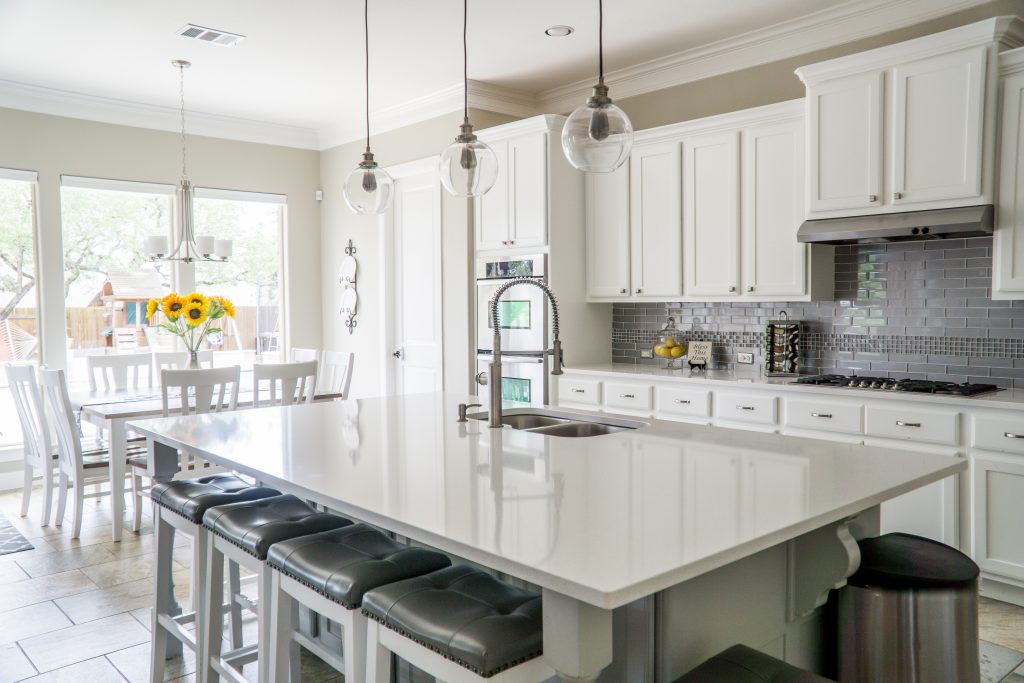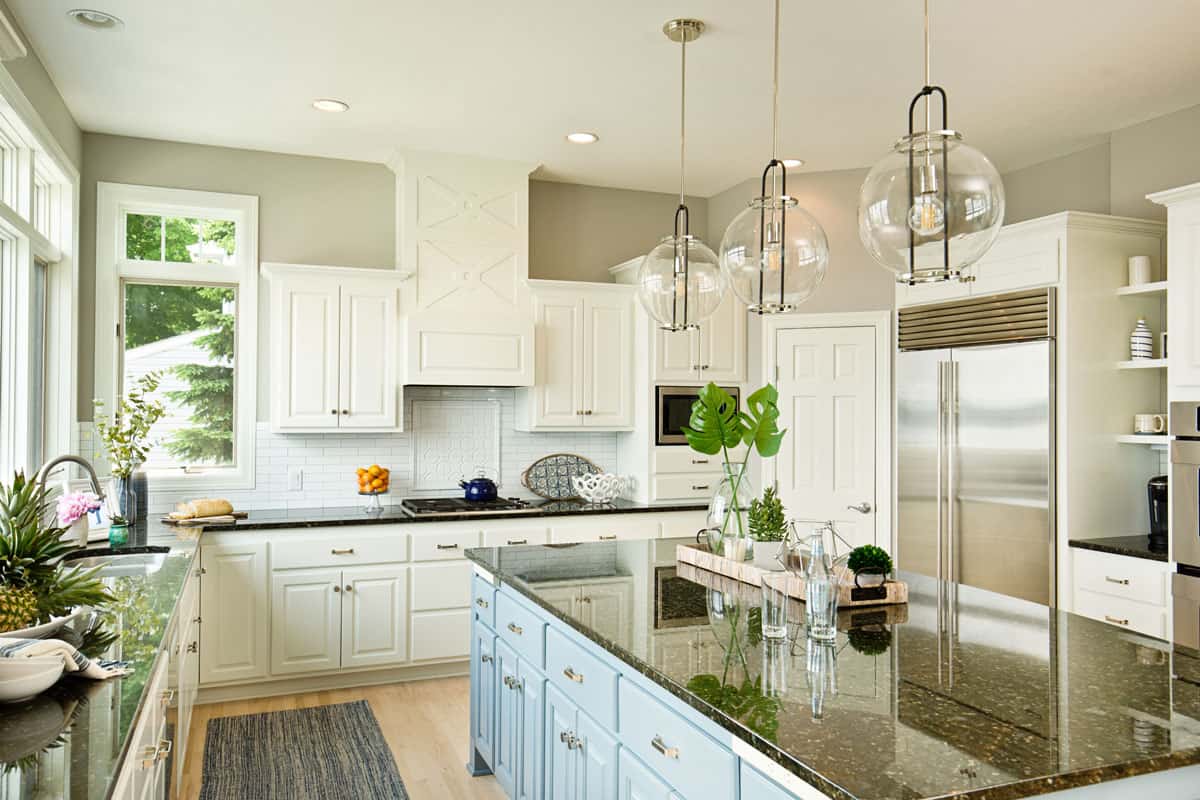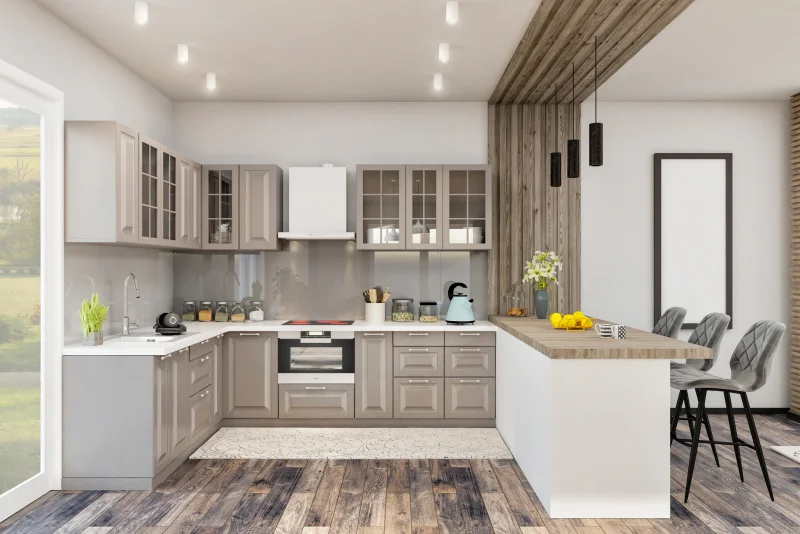Benefits of Tall Kitchen Cabinets to Ceiling

Maximizing vertical space in your kitchen is a smart way to enhance functionality and create a more efficient and organized cooking environment. Tall cabinets that reach the ceiling offer a significant advantage in this regard, providing ample storage space and a streamlined aesthetic.
Increased Storage Capacity
Tall cabinets provide a significant increase in storage capacity, allowing you to store more items while maintaining a clutter-free kitchen. By utilizing the often-unused space between standard cabinets and the ceiling, you gain valuable storage that can be used for a variety of items, such as seldom-used appliances, seasonal dishes, and extra pantry supplies.
Improved Organization, Tall kitchen cabinets to ceiling
Tall cabinets promote a more organized kitchen layout. With ample storage space, you can designate specific areas for different types of items, making it easier to find what you need and keeping your kitchen tidy. By eliminating the need for bulky countertop appliances or overflowing shelves, you create a more spacious and visually appealing work area.
Enhanced Aesthetics
Tall cabinets contribute to a more modern and sleek kitchen design. By extending to the ceiling, they create a sense of continuity and minimize visual breaks, resulting in a cleaner and more streamlined aesthetic. The uninterrupted lines of tall cabinets can make a small kitchen feel larger and more spacious, while in larger kitchens, they can add a touch of sophistication and elegance.
Cost-Effectiveness
While the initial investment in tall cabinets might seem higher, they can be cost-effective in the long run. By maximizing storage space, you may reduce the need for additional storage solutions, such as freestanding shelves or bulky storage containers. This can save you money and create a more streamlined and efficient kitchen environment.
Design Considerations for Tall Kitchen Cabinets

Tall kitchen cabinets reaching the ceiling offer a unique design opportunity, maximizing storage space and creating a sleek, modern aesthetic. However, careful consideration of various design elements is crucial to ensure these cabinets integrate seamlessly with your kitchen’s overall style and functionality.
Cabinet Style and Materials
Choosing the right cabinet style and materials is fundamental to achieving the desired look and functionality. The style of your tall cabinets should complement the existing cabinetry in your kitchen, while the materials should be durable and easy to maintain.
- Traditional Styles: Consider shaker-style cabinets with raised panels for a timeless look. These cabinets often feature simple, elegant hardware and are available in various wood finishes, including cherry, maple, and oak.
- Modern Styles: For a sleek and contemporary aesthetic, opt for flat-panel cabinets with minimal hardware. These cabinets often feature clean lines and bold colors, such as white, gray, or black.
- Materials: Wood is a classic choice for kitchen cabinets, offering durability and warmth. However, other materials like laminate, melamine, and thermofoil offer cost-effective alternatives with a wide range of finishes. Consider the level of moisture and heat exposure in your kitchen when selecting materials.
Cabinet Hardware and Finishes
Cabinet hardware and finishes play a crucial role in defining the overall style and functionality of your tall cabinets.
- Hardware: Handles, knobs, and pulls should complement the cabinet style and overall kitchen design. Modern kitchens often feature minimalist hardware, while traditional kitchens may favor ornate or antique-inspired designs. Consider the size and shape of hardware to ensure easy access to cabinet doors and drawers.
- Finishes: The finish of your tall cabinets should complement the existing countertops, backsplash, and other kitchen elements. Popular finishes include painted, stained, and lacquered. Consider the level of maintenance required for each finish and choose one that aligns with your lifestyle.
Integration with Existing Kitchen Features
Seamlessly integrating tall cabinets with existing kitchen features is essential for a cohesive and functional design.
- Countertops: Tall cabinets should complement the height and style of your countertops. Consider using the same countertop material for a unified look or choosing a contrasting material to create visual interest. Ensure a smooth transition between the countertop and cabinet surfaces to avoid any awkward gaps or misalignments.
- Backsplashes: Tall cabinets should integrate well with the existing backsplash. Consider extending the backsplash to the ceiling to create a cohesive look or using a different material for a distinct visual element. Ensure the backsplash material complements the cabinet finishes and overall kitchen design.
Lighting for Tall Cabinets
Proper lighting is crucial for highlighting the beauty of tall cabinets and maximizing their functionality.
- Under-Cabinet Lighting: Under-cabinet lighting provides task lighting for food preparation and cleaning, while also illuminating the contents of the cabinets. LED strips are a popular choice due to their energy efficiency and bright light output.
- Recessed Lighting: Recessed lighting installed above the cabinets provides general illumination for the kitchen, highlighting the overall design of the tall cabinets. Consider using dimmable lights for adjustable brightness levels.
Installation and Functionality of Tall Kitchen Cabinets: Tall Kitchen Cabinets To Ceiling

Installing tall cabinets to the ceiling requires careful planning and execution to ensure a seamless and functional result. This process involves precise measurements, proper framing, and secure installation techniques. Once installed, these cabinets offer ample storage space, which can be further maximized with thoughtful organization.
Installation Process
The installation process for tall kitchen cabinets is a crucial step in maximizing their functionality and ensuring a well-integrated design.
- Measurements and Planning: Accurate measurements are essential for a successful installation. Measure the height of the ceiling and the width of the space where the cabinets will be placed. Consider the thickness of the countertop and backsplash when calculating the overall height of the cabinets. It’s also important to factor in any existing electrical outlets or plumbing fixtures that might affect the placement of the cabinets.
- Framing and Support: Tall cabinets require strong framing to support their weight. Ensure the existing wall studs are adequately spaced to accommodate the cabinet weight. If necessary, install additional framing to provide extra support.
- Cabinet Installation: Once the framing is in place, the cabinets can be installed. Start by attaching the base cabinets to the floor using screws and anchors. Then, carefully lift and attach the upper cabinets to the wall, ensuring they are level and plumb. Use shims as needed to adjust the cabinets for a perfect fit.
- Securing the Cabinets: After installing the cabinets, secure them to the wall studs using screws or brackets. This ensures stability and prevents the cabinets from shifting or falling.
Cabinet Doors and Drawers
The type of doors and drawers used on tall cabinets can significantly impact their functionality and aesthetics.
- Standard Doors: These are the most common type of doors for kitchen cabinets. They are typically hinged and open outward, providing easy access to the cabinet contents.
- Roll-up Doors: Roll-up doors are a modern alternative to standard doors. They slide up and down on tracks, offering a sleek and space-saving option.
- Sliding Doors: Sliding doors are ideal for narrow spaces or cabinets that are located next to appliances. They move horizontally on tracks, allowing for easy access without taking up extra space.
- Drawers: Drawers are a versatile storage solution for tall cabinets. They can be customized in various sizes and configurations to accommodate different items.
Maximizing Storage Space
Tall cabinets offer ample storage space, but maximizing this space requires thoughtful organization and the use of specialized storage solutions.
- Organizers and Dividers: Organizers and dividers help to create order and maximize space within cabinets. Use adjustable shelves, pull-out drawers, and dividers to separate items and keep them easily accessible.
- Pull-Out Shelves: Pull-out shelves are a great way to access items stored in the back of deep cabinets. They allow you to easily reach items without having to remove everything in front.
- Lazy Susans: Lazy Susans are ideal for storing items in corner cabinets. They rotate, making it easy to access items from all angles.
- Specialized Storage Solutions: Consider using specialized storage solutions for specific items, such as spice racks, utensil holders, and pot and pan organizers.
Kitchen Layout with Tall Cabinets
Tall cabinets can be incorporated into various kitchen layouts, offering both functional and aesthetic benefits.
- L-Shaped Kitchen: Tall cabinets can be used along one or both sides of the L-shaped layout, creating a sense of continuity and maximizing storage space.
- U-Shaped Kitchen: Tall cabinets can be used on one or more sides of the U-shaped layout, providing ample storage and creating a defined workspace.
- Galley Kitchen: Tall cabinets can be used on both sides of the galley kitchen, creating a sense of symmetry and maximizing storage space.
Tall kitchen cabinets to ceiling – Taking your kitchen cabinets all the way to the ceiling is a fantastic way to maximize storage space. But what about those hard-to-reach areas? That’s where the clever design of pull down kitchen cabinets comes in handy. These ingenious systems allow you to easily access even the highest shelves, making the most of your tall cabinets and ensuring everything is within reach.
Maximizing storage space is key in any kitchen, and tall cabinets reaching the ceiling offer a fantastic solution. If you’re in the Minneapolis area and looking for top-notch kitchen cabinetry, check out kitchen cabinets in Minneapolis for inspiration and expert guidance.
These tall cabinets can be customized to fit your style and needs, making them a stylish and functional addition to any kitchen.
